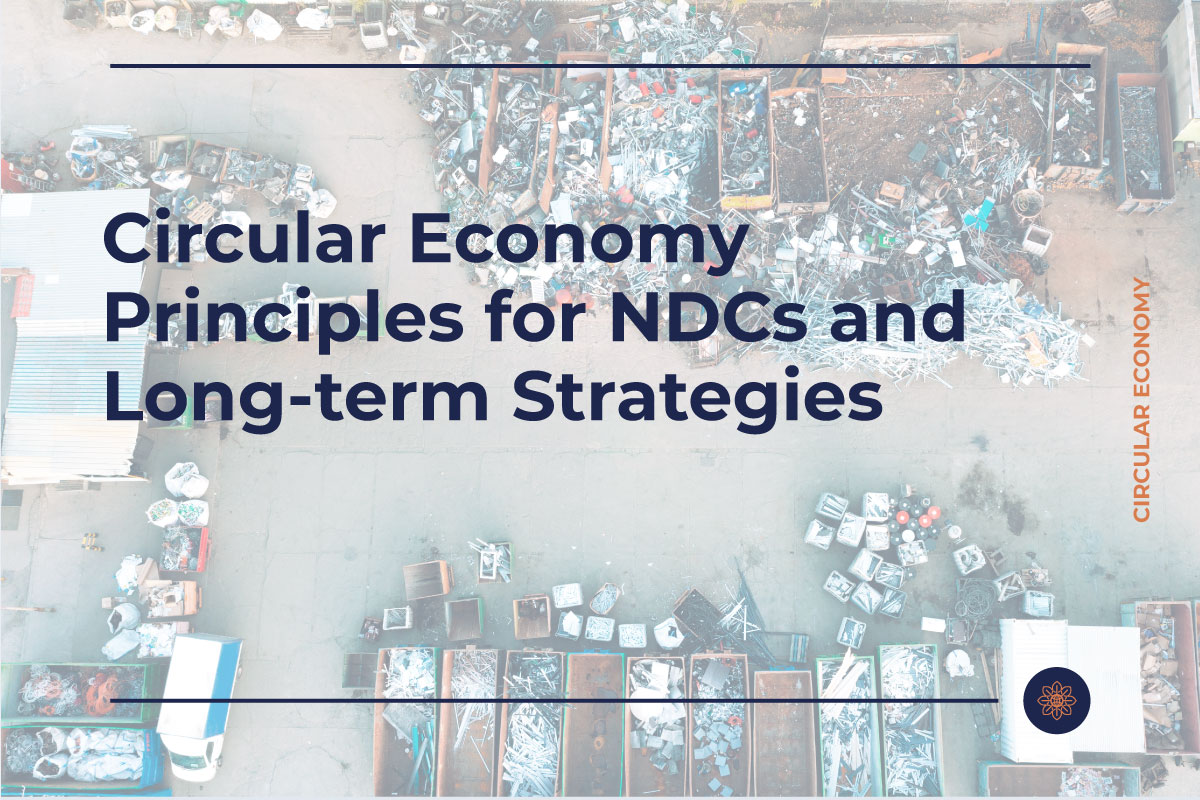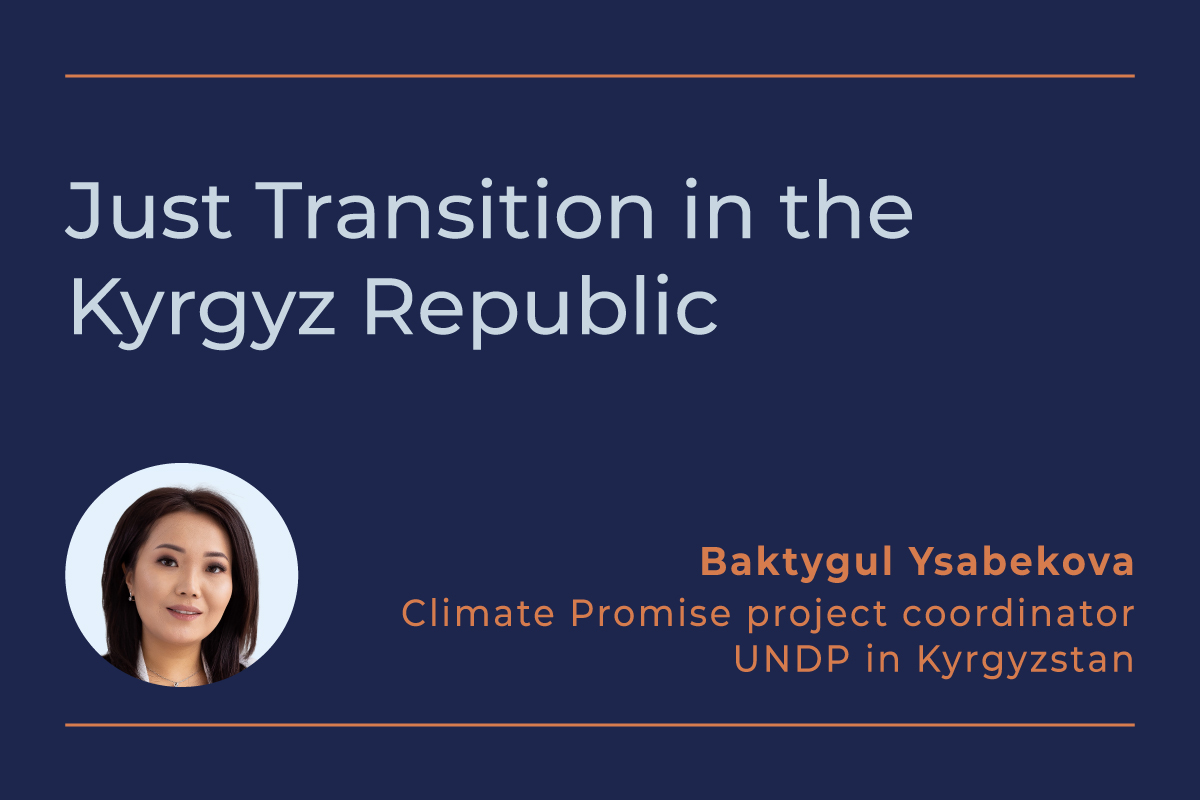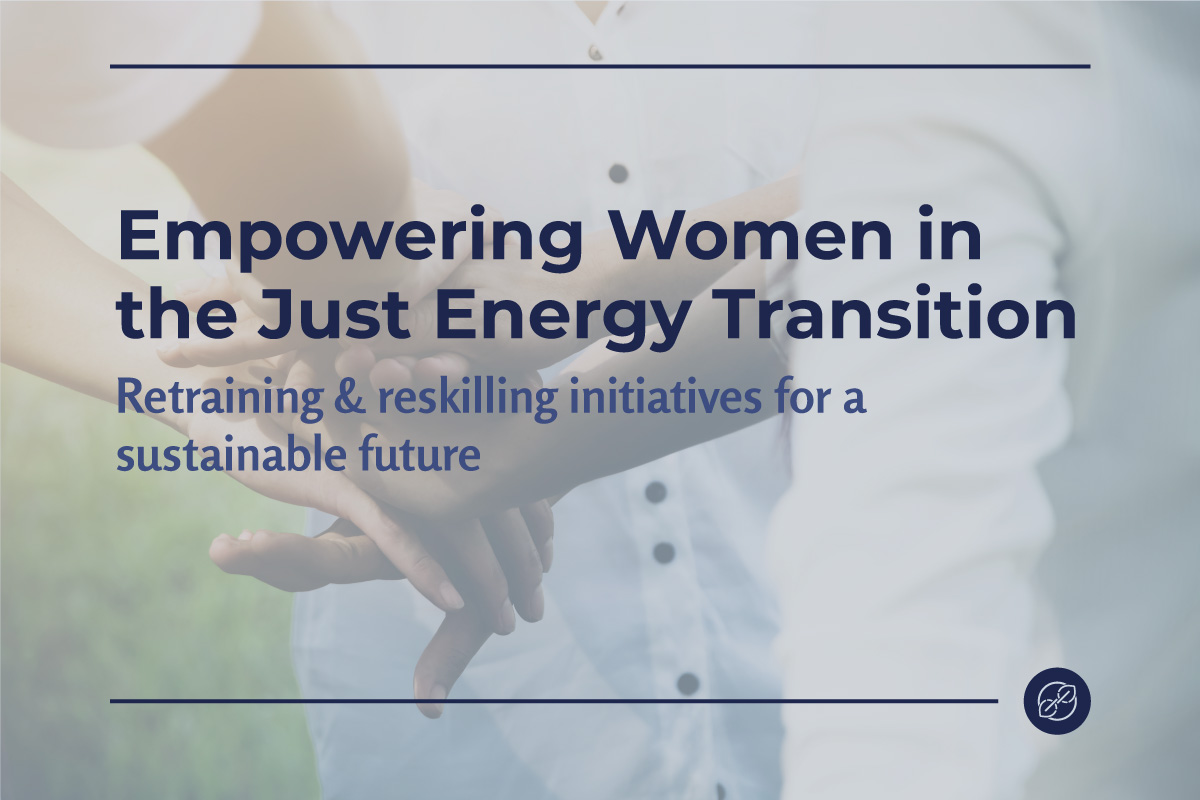Key Messages
- Building on circular economy approaches when designing long-term climate strategies could promote the dual objectives of sustainable economic development and climate neutrality.
- NDC targets and Circular Economy Strategies are complementary. Circular economy strategies can reduce the current emissions gap by half and should thus be included in the NDC revisions.
- Incorporating circular economy strategies in the NDC revision process can increase the level of ambition of national climate action by looking beyond the classical mitigation sectors.
- Circular economy strategies are about more than just recycling. They look at the policies on material management at a holistic level, thinking about the fundamental way we interact with these materials
- Countries should start developing a strategy for economic diversification, taking advantage of new job opportunities and entrepreneurial possibilities through a circular economy approach. Circularity would enable nations to close material loops through increased reuse of materials.
- Circularity principles are not only for industrialised countries; they benefit developing countries as well. By implementing circular principles, they can organise their national goals to have both sustainability and economic growth.
Introduction
As part of the 2019 World Bank Innovate4Climate (I4C) conference in Singapore in June 2019, the United Nations Development Programme (UNDP) and NEYEN organised a workshop exploring the benefits and challenges of incorporating circular economy principles in the Nationally Determined Contributions (NDCs) during the 2020 revision process and in the 2050 strategies.
Two fundamental aspects were discussed:
- Increasing the level of ambition of NDCs and better alignment with SDGs,
- How a circular economy approach can support comprehensive mid-century, long-term strategies in the context of the Paris Agreement.
Background
The Paris Agreement aims at “strengthening the global response to the threat of climate change, in the context of sustainable development and efforts to eradicate poverty” (PA art. 2). While the landmark Agreement defines climate action in the context of sustainable development, countries have focused their NDCs climate actions mostly on project level mitigation actions, targeting a handful of sectors, which were also addressed as classical mitigation sectors under the Kyoto Protocol. However, with this narrow sectoral focus and lack of ambition, the current NDC commitments are not enough to ensure the long-term goal of decarbonisation of the Paris Agreement. According to the latest IPCC report, we must bend the curve before 2030 to stabilise global temperature increase to 1.5C.
During the Innovate4Climate workshop, panelists discussed the need to mobilise a more comprehensive approach to climate action that focuses on transformational change and moves away from incremental actions. NDCs today include a discrete number of individual actions, focused mainly on the energy sector without looking at the entire value chain and the circularity of the economy. In the words of Massamba Thioye, Manager of the Sustainable Development Mechanism at UNFCCC, “This transformational change needs to relate to the economy and society as a whole”.
Miguel Rescalvo, partner at Neyen, facilitated the panel, opening the discussion with an overview of the regional efforts proposed in NDCs and a parallelism with what is being done in different circular economy initiatives. The challenge was proposed then on how to integrate those efforts towards a more comprehensive approach to climate action and sustainable development.
Currently, the global economy is only 9% circular[1], but climate change is closely linked with material use: over 50-65% of total GHGs globally are related to materials management processes[2]. Global use of materials is increasing, having more than tripled since 1970. Without any action being taken, it could double again by 2050. High material consumption continues to be an important factor in energy demand, and therefore in GHG emissions. Framing the climate problem as a materials problem offers a new way of looking at the issue, bringing new solutions to the table. Few governments consider circularity measures in climate policies, despite the synergy between the two. Circularity also enables NDCs to better align with SDG 12: ensure sustainable consumption and production patterns.
Daniel Calleja Crespo, Director-General, Directorate-General for Environment, European Commission, provided an overview on how Europe is working to integrate circular economy principles across sectors and emphasised how this must be an inclusive effort of all society. Circular economy is shifting paradigms in the way we produce and consume, shifting emphasis to the recirculation and reuse of materials. Encouraging member states to develop more circular actions in their national plans leads to greater overall coherence in national policies. Furthermore, the buy-in from stakeholders is also important. He explained how a circular economy platform brings together companies, academia and stakeholders, cities and regions across Europe.
Bradley Busetto, Director, Global Centre for Technology, Innovation and Sustainable Development, UNDP, highlighted the importance of finding economic opportunities and encouraging private sector funding in circular economy-related sectors. This requires targeted support by the government. Identifying the right incentives to spur radical transformation is also central to this process.
Discussion Highlights
NDC targets and Circular Economy Strategies are complementary with the ultimate objective to achieve Long-Term Low Carbon Strategies. Circular economy strategies can help countries achieve their NDC targets. The trend in developing countries is an inverse relationship between economic growth and resource efficiency. As over half of total greenhouse gases (GHGs) are related to material usage, we must consider how we can structure production and consumption to emit less carbon dioxide (CO2), and how we shift from a quantitative consumption to a qualitative one, i.e. producing less but of higher quality or service based business models. Income is earned from service, maintenance and recycling. Circular economy measures can reduce the current emissions gap by half and should therefore be included in the next revision of NDCs.
Building on circular economy approaches when designing long-term climate strategies could promote the dual objectives of sustainable economic development and climate neutrality. In the context of NDC revisions for 2020, the Paris Agreement is not only about reducing emissions but also about sustainable development impacts at the national level. Along these lines, circular economy strategies take sustainable economic development into account. Material flows and the promotion of internal use of resources add to a country’s internal economic development.
Circular economy strategies are about more than just recycling. They look at the policies on material management at a holistic level, thinking about the fundamental way we interact with these materials. A large part of energy consumption and related GHG emissions are linked to the material supply chain–extraction, processing, transportation, use and discarding of materials. Carefully managed material flows and the promotion of internal recirculation of resources can strengthen the development of the economy of a country.
Along with their NDCs, countries should start developing a strategy for economic diversification, taking advantage of new job opportunities and entrepreneurial possibilities through a circular economy approach. Seumkham Thoummavongsa, Deputy Director General Institute of Renewable Energy Promotion, Ministry of Energy and Mines, Lao PDR, provided examples from Lao PDR. The case of Laos is one of an early mover. With the support of UNDP, Laos developed a strategic position to linking circularity with its overarching national plan, for example, using natural and recycled materials in the development of new facilities in its tourism sector.
Ousmane Fall Sarr, Coordinator, West African Alliance on Carbon Markets and Climate Finance, provided examples from West Africa. Ghana, for instance, has seen plastic waste recycled into building materials with strong engagement of the private sector. Ghana also uses blockchain technologies for the management of building materials. These circular economy strategies could well be replicated in other countries in the region such as Senegal.
Incorporating circular economy strategies in the NDC revision process can increase the level of ambition of national climate action. As we approach the next round of NDC revisions, many countries will decide how to make their NDCs more ambitious. NDCs do not necessarily need to focus only on the classical mitigation sectors but could also consider circular economy strategies and enablers such as (i) sustaining and preserving what is already there, (ii) using waste as a resource, (iii) prioritising regenerative resources, (iv) rethinking business models, (v) designing for the future, (vi) incorporating digital technologies to optimise resource use and strengthening connections between supply chains, and (vii) teaming up to create joint value throughout supply chains[3].
As highlighted by Koji Fukuda, Chief Advisor for the Technical Assistance for Capacity Development to Accelerate Low Carbon and Resilient Society Realization, JICA, we can see how circular economy strategies can increase a Party’s level of ambition based on the example of Japan. As the country’s work on a circular economy approach preceded the Paris Agreement, Japan’s action plan is updated every five years to include a cycle of more ambitious targets, including those for resource productivity, waste disposal, and cyclical material use, which links with its NDCs. These circular economy actions display mitigation ambition.
GHG emissions reached 51 billion tonnes of CO2e per year in 2017 and are forecasted to reach 60 billion tonnes by 2050, even if all current mitigation ambitions are implemented. Current commitments address only half the gap between BAU and 1.5C scenarios. A reduction of 15 billion tonnes is still required. The NDCs and new circular economy strategies can work in tandem to bridge the gap. To reach the Paris goals, annual emissions must stay below 39 billion tonnes CO2e per year by 2030.
Circularity would enable nations to close material loops through increased reuse of materials. In 2015, globally 84.4 billion tonnes of resources were extracted per year. 19.4 billion tonnes, or 30%, was collected as waste. Of this, only 9.1% was cycled, with the remainder incinerated, landfilled, or dumped into the environment[4].
Circularity principles are not only for industrialised countries; they benefit developing countries as well. Often developing countries are at a disadvantage because sustainability measures are at odds with their potential economic growth. By implementing circular principles, they can organise their national goals to have both sustainability and economic growth. Additionally, circular economy strategies support job creation and new industries involved in remanufacturing, technological transfer and in particular a shift to the service and maintenance sector.
Digital, physical and biological technology innovation linked to circularity will be paramount to the new circular economy model. Circular economy depends on new technological innovation, and newer technologies tend to be both more efficient and cost-effective, leading to further opportunities to close material loops. Digital services lead to a smarter use of resources and more sustainable consumption patterns. The process of technological transfer creates new jobs and the technical skills needed in refurbishing and remanufacturing equipment. Physical services are being replaced by online equivalents, and the economy could move from an ownership model to a shared-use one, effectively dematerialising services.
According to Daniel Calleja, technology and innovation are necessary instruments to build CE. There are a lot of opportunities for companies linked to reducing emissions. We need countries to step up their efforts and include circular strategies in their national plans.
Possibilities for entrepreneurship abound within the circular economy. Technological innovations will lead to new industries being set up. Digital technologies such as machine learning, and robotics have helped with waste collection processes. Physical technology such as 3D printing can minimise generation of waste. Biological technologies, while still in an early phase of development, can create minimally wasteful replacements for current products that produce inorganic waste. However, circular economy will also have a big impact on labor which requires some dramatic shifts. It’s therefore critical to look at impacts and mitigation measures, including social, educational and labor policies.
In an example given by Bradley Busetto, Singaporean government support is driving the private sector to take action, and circularity is evolving out of the notion of “smart cities”. This circular economy-friendly environment has led to various innovative startups, such as one that rethinks compostable food waste management by creating plastics that can be digested and turned into compost.
Challenges to a Circular Economy Transition
Transitioning to a circular system from a linear one is not without its challenges. According to Koji Fukuda, basic building blocks of infrastructure, legal systems and institutional frameworks need to be put in place before they can fully engage with circular approaches. Developing countries especially tend to be focused on economic growth at the expense of sustainability; however, introducing circular economy strategies into their NDCs would join climate action with economic development.
Ousmane Fall Sarr noted challenges specific to developing countries such as those in West Africa that export raw materials, as they would be impacted by a decrease in import demand from industrialised countries. When countries decrease their level of imports, exporting countries must make up the difference in their economy in other ways. Accounting for this at a national level would enable countries to make plans to use these materials internally. However, circularity would allow to plan for job creation and the need for developing skills for refurbishing and remanufacturing equipment, and the setting up the process of technological transfer to create new industries.
Some barriers are related to regulatory and institutional frameworks. Ministries tend to have a linear viewpoint and work in silos, which reduces the impacts of policy incentives. Miguel Rescalvo explained his experience when trying to fund a program for energy efficiency in appliances, specifically washing machines. These interventions have an energy-saving component and an equally relevant or even more important water-saving one. With energy and water controlled by different ministries, the program did not move forward as neither of the two ministries took a real leading position, each instead waiting for the other to lead. In West Africa, a lack of an appropriate regulatory framework for procurement of material leads to miscommunication between ministries despite attempts to be sustainable. This is evidenced by the example of plastic waste being used to manufacture bricks and the question of whether it falls under the departments–and thus regulations–of urban planning or waste. A comprehensive waste management strategy could curb this miscommunication.
These institutional barriers can be overcome by cooperation and collaboration between departments, as described by Daniel Calleja. Four years ago, the EU started a circular economy action plan using a strategy that covered all relevant departments, from agriculture to transport to energy to environment. This led to a 54-measure plan, which covered the basic elements of the economy, from production to consumption, to waste and recycling and raw materials, dealing with specific sectors like plastics and construction. All these have been delivered, not only by the commission but adopted at countries level.
Securing green finance remains crucial. Often countries lack the funds to overcome the initial hurdles of transitioning to a circular model. As the global discussion moves more and more towards circularity, more public and private funding opportunities should arise. Daniel Calleja further emphasised that we will not make the transition to circularity without the participation of the financial sector. In terms of the transition to circularity alone, 300 billion euros will need to be mobilised in Europe. Tax instruments and new regulations are needed as well. Examples in the EU include putting a tax on landfills to incentivise a reduction in pollution and an increase in recycling and banning single use plastics due to their role in marine pollution, among others.
As of now, there are not yet solid methodologies for measuring circularity impacts in national and international climate actions, and it’s specifically lacking in the UNFCCC reporting process. There is a need to develop decision metrics and a measurement framework to account for circularity, including GHG accounting methodologies so that circularity actions eventually incorporated into NDCs can be accounted for.
Conclusion
To reach the goals of the Paris Agreement, the global community must take actions to bridge the circularity gap using creative and innovative solutions. Global ideas can be translated into national, regional and commercial pathways, allowing downstream level to make strategies that are aligned with the local context. Actions taken at the national, NDC levels will undoubtedly propagate downstream.
We have seen examples from Europe, to West Africa, to Asia on how a transition to circular economy could work. While there are barriers to implementing circularity, we have no time to lose. Circularity at the NDC level can be the key to moving from incremental improvement to deep societal transformation.
[1] Circle Economy. (2019). The Circularity Gap Report – 2019.
[2] OECD (2012), Greenhouse gas emissions and the potential for mitigation from materials management within OECD countries.
[3] Shifting Paradigms. (2019). Metabolic analysis and circular economy strategies for Almaty Oblast, Kazakhstan
[4] Circle Economy. (2019). The Circularity Gap Report – 2019.




